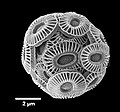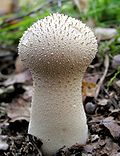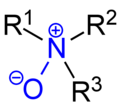In aquatic toxicology, bioconcentration is the accumulation of a water-borne chemical substance in an organism exposed to the water. There are several...
16 KB (1,887 words) - 17:00, 26 November 2024
the environment. Bioconcentration is defined as occurring when uptake from the water is greater than excretion. Thus, bioconcentration and bioaccumulation...
11 KB (1,284 words) - 01:18, 10 June 2025
compared to its surroundings (air or water), it is referred to as bioconcentration. Biomagnification is another process related to bioaccumulation as...
20 KB (2,276 words) - 20:52, 22 May 2025
areas. The movement of dioxins through the food web has resulted in bioconcentration and biomagnification. The areas most heavily contaminated with dioxins...
153 KB (16,820 words) - 03:59, 26 May 2025
PMID 15743763. Obata, T.; H. Araie; Y. Shiraiwa (2003). "Kinetic studies on bioconcentration mechanism of selenium by a coccolithophorid, Emiliania huxleyi". Plant...
30 KB (3,231 words) - 06:34, 23 May 2025
organism may lead to cumulative toxicity. Bioaccumulation tests use bioconcentration factors (BCF) to predict concentrations of hydrophobic contaminants...
29 KB (3,541 words) - 10:47, 29 May 2025
humans, although plants and livestock also contain mercury due to bioconcentration of organic mercury from seawater, freshwater, marine and lacustrine...
84 KB (8,853 words) - 20:00, 12 June 2025
S2CID 58660816. Martin JW, Mabury SA, Solomon KR, Muir DC (January 2003). "Bioconcentration and tissue distribution of perfluorinated acids in rainbow trout (Oncorhynchus...
170 KB (17,644 words) - 17:07, 5 June 2025
of measurement Blake canonical form, a class of logical expressions Bioconcentration factor, the accumulation of a chemical in or on an organism when the...
2 KB (269 words) - 14:06, 5 June 2025
can rapidly volatilize from water surfaces, and its potential for bioconcentration in aquatic organisms is considered low. Occupational exposure to 1-chloropropane...
5 KB (342 words) - 14:48, 11 March 2025
(Müller, 1774): Filtration rate, biochemical biomarkers and mercury bioconcentration". Ecotoxicology and Environmental Safety. 164: 155–163. Bibcode:2018EcoES...
210 KB (22,242 words) - 17:47, 11 June 2025
significantly influenced by hydrolysis, oxidation, volatilization, bioconcentration, or adsorption to sediment. Propylene glycol is readily biodegradable...
48 KB (5,044 words) - 21:59, 29 May 2025
Garcia MA (2009). "Mercury in edible mushrooms and underlying soil: Bioconcentration factors and toxicological risk". Science of the Total Environment....
86 KB (9,710 words) - 20:47, 24 May 2025
48-hour LC50 values for fish are between 0.1 and 1.1 mM. Also the bioconcentration factor for fish is very low. In nature bacteria play a major role in...
23 KB (2,533 words) - 12:26, 24 May 2025
ingestion, exposure, and inhalation. Bioaccumulation is broken down into bioconcentration (uptake of chemicals from the environment) and biomagnification (increasing...
95 KB (10,410 words) - 17:34, 29 May 2025
A, Dadej M, Jedrusiak A, Puzyn T (2003). "Mercury content and its bioconcentration factors in wild mushrooms at Łukta and Morag, northeastern Poland"...
40 KB (3,935 words) - 05:29, 2 June 2025
IC, Sajwan KS, Falandysz J (2012). "Mercury in Russula mushrooms: Bioconcentration by Yellow-ocher Brittle Gills Russula ochroleuca". Journal of Environmental...
28 KB (2,661 words) - 06:35, 12 June 2025
suggests lipophilicity and potential to bioaccumulate, comparison of bioconcentration factors (BCF) reported for plant and animal species in comparison to...
25 KB (3,254 words) - 03:05, 28 May 2025
sewage. Once they reach the aquatic environment, they possibly undergo bioconcentration and bioaccumulation through the food web. Psychiatric drugs, such as...
16 KB (2,393 words) - 12:20, 23 May 2025
categorize regulated substances. Bioaccumulation in fish using the Bioconcentration Factor (BCF) methods. Total amount of acute toxicity is directly related...
21 KB (2,571 words) - 10:58, 29 May 2025
aquatic species based on log Kow data from chain lengths less than C14 (bioconcentration factor < 87%). Levels of AO in untreated influent were found to be...
12 KB (1,327 words) - 15:26, 8 June 2025
biological response and it is estimated using a partition coefficient and a bioconcentration factor. The whole-body residues are reasonable first approximations...
11 KB (1,283 words) - 02:28, 26 May 2025
does not significantly bioaccumulate in organisms due to low Kow and bioconcentration factors. It is not found to be genotoxic or carcinogenic and has been...
16 KB (1,884 words) - 21:49, 29 May 2025
Dryzalowska A, Nnorom IC, Falandysz J (2012). "Concentrations and bioconcentration factors of minerals in yellow-cracking bolete (Xerocomus subtomentosus)...
14 KB (1,456 words) - 08:43, 7 March 2025
Kannan K, Szefer P (2012). "Mercury in bay bolete (Xerocomus badius): Bioconcentration by fungus and assessment of element intake by humans eating fruiting...
40 KB (4,289 words) - 16:35, 11 June 2025
with odor thresholds of 1 ng/L or less. Galaxolide has a measured bioconcentration factor (BCF) in fish in a range of 600-1600 and a log octanol-water...
19 KB (2,328 words) - 21:53, 5 October 2024
products. Azoxystrobin is categorized as having a low potential for bioconcentration and of moderate risk to fish, earthworms and bees but of high risk...
28 KB (2,784 words) - 15:40, 29 May 2025
Emiliania huxleyi, a major species of coccolithophorid active in selenium bioconcentration Warr, L.N. (2021). "IMA–CNMNC approved mineral symbols". Mineralogical...
4 KB (250 words) - 23:56, 18 January 2024
AlgaeBase. Retrieved 2012-10-05. Garcia, E. M.; Reyes, R. E. (1996). "Bioconcentration of Hg in Acetabularia caliculus: Evidence of a polypeptide in whole...
4 KB (539 words) - 18:04, 10 March 2021
principal class members; others that are trace metals of especially low bioconcentration are not explored herein. Some elements that are nonmetals or metalloids...
23 KB (2,742 words) - 05:27, 2 June 2025





















